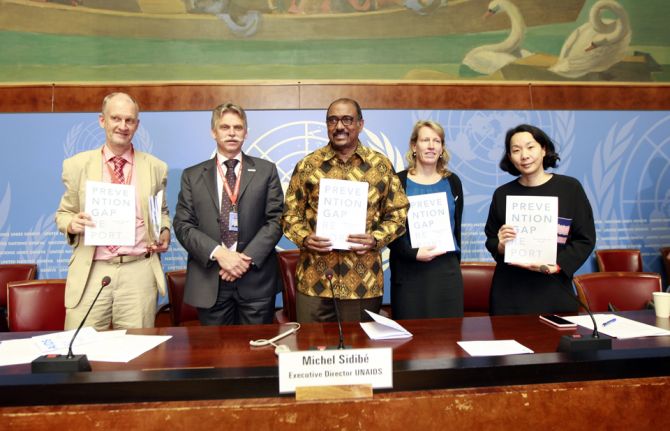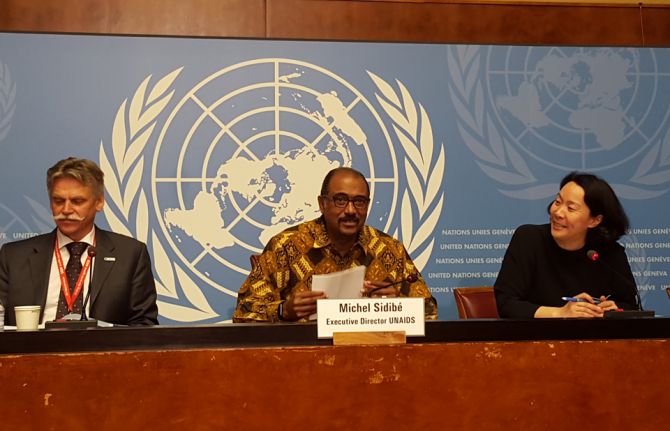



Press Release
UNAIDS warns that after significant reductions, declines in new HIV infections among adults have stalled and are rising in some regions
11 July 2016 11 July 2016Globally, new HIV infections among adults and children were reduced by 40% since the peak in 1997. However, new analysis from UNAIDS shows that new HIV infections among adults have stalled, failing to decline for at least five years. The report outlines what is needed to step up prevention efforts
GENEVA, 12 July 2016—A new report by UNAIDS reveals concerning trends in new HIV infections among adults. The Prevention gap report shows that while significant progress is being made in stopping new HIV infections among children (new HIV infections have declined by more than 70% among children since 2001 and are continuing to decline), the decline in new HIV infections among adults has stalled. The report shows that HIV prevention urgently needs to be scaled up among this age group.
HIV prevention gap among adults
The Prevention gap report shows that an estimated 1.9 million adults have become infected with HIV every year for at least the past five years and that new HIV infections among adults are rising in some regions. The Prevention gap report gives the clear message that HIV prevention efforts need to be increased in order to stay on the Fast-Track to ending AIDS by 2030.
- Eastern Europe and central Asia saw a 57% increase in annual new HIV infections between 2010 and 2015.
- After years of steady decline, the Caribbean saw an 9% rise in annual new HIV infections among adults between 2010 and 2015.
- In the Middle East and North Africa, annual new HIV infections increased by 4% between 2010 and 2015.
- There have been no significant declines in any other regions of the world.
- In Latin America the annual number of new adult HIV infections increased by 2% since 2010; New HIV infections declined marginally in western and central Europe and North America and in western and central Africa since 2010; New HIV infections among adults declined by 4% in eastern and southern Africa since 2010, and by 3% in Asia and the Pacific since 2010.
“We are sounding the alarm,” said Michel Sidibé, Executive Director of UNAIDS. “The power of prevention is not being realized. If there is a resurgence in new HIV infections now, the epidemic will become impossible to control. The world needs to take urgent and immediate action to close the prevention gap.”
The AIDS epidemic has had a huge impact over the past 35 years. Since the start of the epidemic, 35 million people have died from AIDS-related illnesses and an estimated 78 million people have become infected with HIV.
Equity and access for key populations
In 2014, key populations, including gay men and other men who have sex with men, sex workers and their clients, transgender people, people who inject drugs and prisoners, accounted for 35% of new HIV infections globally. It is estimated that men who have sex with men are 24 times more likely to become infected with HIV than the general population, while sex workers are 10 times more likely and people who inject drugs are 24 times more likely to become infected than the general population. In addition, transgender people are 49 times more likely to be living with HIV and prisoners are five times more likely to be living with HIV than adults in the general population
It is essential for key populations to have access to the full range of HIV prevention options in order to protect themselves and their sexual partners from HIV. “Today, we have multiple prevention options,” said Mr Sidibé. “The issue is access—if people do not feel safe or have the means to access combination HIV prevention services we will not end this epidemic.”
Prevention dividend from HIV treatment still to be realized
The report highlights that the major hopes for antiretroviral therapy to have an impact on preventing new HIV infections are starting to be realized, although the full benefits may not be seen for some years.
The Prevention gap report estimates that over half of all people living with HIV, 57%, now know their HIV status, that 46% of all people living with HIV have access to antiretroviral treatment and that 38% of all people living with HIV have viral suppression, keeping them healthy and preventing onward transmission of the virus. This underscores the urgent need for the UNAIDS 90–90–90 targets to be met to realize the full potential of antiretroviral therapy. The 90–90–90 targets are 90% of people knowing their HIV status, 90% of people who know their status accessing antiretroviral treatment and 90% of people on treatment having suppressed viral loads.
HIV prevention funding gap
The reports of rising numbers of new HIV infections are coming as data reveal donor funding has declined to its lowest levels since 2010. International donor contributions dropped from a peak of US$ 9.7 billion in 2013 to US$ 8.1 billion in 2015. Low- and middle-income countries are stepping up to fill the gap, with domestic resources accounting for 57% of the US$ 19.2 billion total funding in 2015.
The report notes that although international funding, the main source of funding for HIV prevention for people at higher risk of HIV, has reduced, some major donors are making bold commitments to ensure that funding reaches the people most affected by HIV. In June 2016, the United States of America announced the launch of a new US$ 100 million Key Populations Investment Fund to increase access to HIV services for key populations.
The current allocation of resources for HIV prevention is falling far short of what is needed. Currently, 20% of global resources for HIV are being spent on HIV prevention. The report indicates that to have maximum impact funding should focus on the location and population approach in order to reach people at higher risk with combination prevention options where they live and work.
Regional HIV prevention gaps
The report details the trajectory of new HIV infections and looks at which populations and which locations are most affected. It also outlines where countries need to make more tailored HIV prevention investments.
In eastern and southern Africa, for example, three quarters of all new HIV infections among adolescents aged 10–19 years are among adolescent girls. Adolescent girls are often prevented from accessing HIV services owing to gender inequality, a lack of age-appropriate HIV services, stigma, a lack of decision-making power and gender-based violence. In 2014, only 57% of countries globally (of 104 countries reporting) had an HIV strategy that included a specific budget for women. It is estimated that worldwide only three in 10 adolescent girls and young women between the ages of 15 and 24 years have comprehensive and correct knowledge about HIV. Reaching adolescent girls and young women, especially in sub-Saharan Africa, will be a key factor in ending the AIDS epidemic.
In eastern Europe and central Asia, 51% of new HIV infections occur among people who inject drugs. More than 80% of the region’s new HIV infections in 2015 were in the Russian Federation. The epidemic is concentrated predominantly among key populations and their sexual partners, in particular people who inject drugs, who accounted for more than half of new HIV infections in 2015. However there is very low coverage of prevention programmes, in particular harm-reduction interventions among people who inject drugs.
In the Middle East and North Africa, 96% of new HIV infections occur among key populations, predominantly among people who inject drugs, men who have sex with men and female sex workers and their sexual partners. However, prevention programmes for men who have sex with men and sex workers rarely receive support from domestic resources or through public services.
In western and central Europe and North America, around half of all new HIV infections occur among gay men and other men who have sex with men and while a significant proportion of resources are being invested for this key population group, prevention efforts are failing to have an impact. Between 2010 and 2014, new HIV diagnoses among men who have sex with men increased by 17% in western and central Europe, and by 8% in North America.
The report shows the complexity of the AIDS epidemic and how the populations and locations most affected change dramatically across each country and region. It also shows that investments need to be made in effective HIV programmes that are proven to make a significant difference in reducing the number of new HIV infections.
Combination HIV prevention, gaps and opportunities
Compared to 20 years ago when HIV prevention options were limited, there is now a range of options available to suit people’s needs throughout their lives to ensure that they can protect themselves from HIV.
UNAIDS urges countries to take a location and population approach to HIV programming efforts following five prevention pillars, to be delivered comprehensively and in combination:
- Programmes for young women and adolescent girls and their male partners in high-prevalence locations.
- Key population services in all countries.
- Strengthened national condom programmes.
- Voluntary medical male circumcision in priority countries.
- PrEP for population groups at higher risk of HIV infection.
Closing the HIV prevention gap
“Science, innovation and research have provided new and effective HIV prevention options, rapid diagnostics and improved treatment for HIV,” said Mr Sidibé. “Investing in innovation is the only way to secure the next big breakthrough—a cure or a vaccine.”
The data in the report, collected from more than 160 countries, demonstrate that enormous gains can be achieved when concerted efforts are made. It outlines that by 2015 some 17 million people had access to antiretroviral therapy, double the number in 2010 and 22 times the number in 2000.
UNAIDS will be calling on implementers, innovators, communities, scientists, donors and others at the 2016 International AIDS Conference, taking place from 18 to 22 July, in Durban, South Africa, to close the prevention gap.
|
Global summary of the AIDS epidemic in 2015 |
||
|
Number of people living with HIV |
Total |
36.7 million [34.0 million–39.8 million] |
|
Adults |
34.9 million [32.4 million–37.9 million] |
|
|
Women |
17.8 million [16.4 million–19.4 million] |
|
|
Children (<15 years) |
1.8 million [1.5 million–2.0 million] |
|
|
Number of people newly infected with HIV |
Total |
2.1 million [1.8 million–2.4 million] |
|
Adults |
1.9 million [1.7 million–2.2 million] |
|
|
Children (<15 years) |
150 000 [110 000–190 000] |
|
|
AIDS-related deaths |
Total |
1.1 million [940 000–1.3 million] |
|
Adults |
1.0 million [840 000–1.2 million] |
|
|
Children (<15 years) |
110 000 [84 000–130 000] |
|
|
Number of people on HIV treatment |
Total |
17 million |
UNAIDS
The Joint United Nations Programme on HIV/AIDS (UNAIDS) leads and inspires the world to achieve its shared vision of zero new HIV infections, zero discrimination and zero AIDS-related deaths. UNAIDS unites the efforts of 11 UN organizations—UNHCR, UNICEF, WFP, UNDP, UNFPA, UNODC, UN Women, ILO, UNESCO, WHO and the World Bank—and works closely with global and national partners towards ending the AIDS epidemic by 2030 as part of the Sustainable Development Goals. Learn more at unaids.org and connect with us on Facebook, Twitter, Instagram and YouTube.
Press centre
Download the printable version (PDF)
